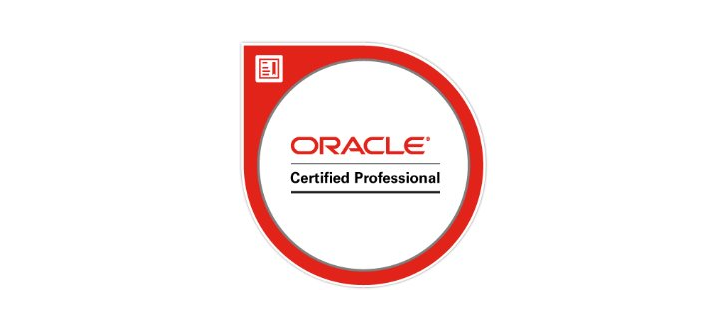
Oracle Certified Professional (OCP)
Who Should do this Course/Pre-requisition
OCA
Duration :
1 Month
Exam Code :
OCA (Oracle Certified Administrator)
Oracle Database 10G: Administration Workshop II (1Z0-043)
Why INFOBIT :
Infobit Technologies is a leader in the high end Latest technologies IT education industry and ITES . Organizations continue to upgrade, standardize and integrate their systems to develop and sustain their competitive edge.
- Oracle Certified & Industrial Experienced Trainer
- Totally Practical Training on ORACLE LAB
- Dedicated Lab Facility
- JOB Assistance
Oracle Database 10g Administrator2
- Course Content
| Using Globalization Support Objectives | |
| [] | Customize language-dependent behavior for the database and individual sessions |
| [] | Specify different linguistic sorts for queries |
| [] | Use datatime datatypes |
| [] | Query data using case insensitive and accent insensitive searches |
| [] | Obtain Globalization support configuration information |
| Configuring Recovery Manager | |
| [] | Configure database parameters that affect RMAN operations |
| [] | Change RMAN default settings with CONFIGURE |
| [] | Manage RMAN's persistent settings |
| [] | Start RMAN utility and allocate channels |
| Recovering from User Errors | |
| [] | Recover a dropped table using Flashback technology |
| [] | Perform Flashback table operation |
| [] | Manage the recycle bin |
| [] | Recover from user errors using Flashback versions query |
| [] | Perform transaction level recovery using Flashback Transaction query |
| Dealing with Database Corruption | |
| [] | Define block corruption and list its causes and symptoms |
| [] | Detect database corruptions using the following utilities: ANALYZE DBVERIFY |
| [] | Detect database corruptions using the dbms_repair package |
| [] | Implement the DB_BLOCK_CHECKING parameter to detect corruptions |
| [] | Repair corruptions using RMAN |
| Automatic Database Management | |
| [] | Use the Database Advisors to gather information about your database |
| [] | Use the SQL Tuning Advisor to improve database performance |
| [] | Use automatic undo retention tuning |
| Database Recovery | |
| [] | Recover the control file |
| [] | Explain reasons for incomplete recovery |
| [] | Perform incomplete recovery using EM |
| [] | Perform incomplete recovery using RMAN |
| [] | Perform incomplete recovery using SQL |
| [] | Perform database recovery following a RESETLOGS operation |
| Flashback Database | |
| [] | Determine which flashback technology to use for each recovery situation |
| [] | Configure and use Flashback Database |
| [] | Monitor the Flashback Database |
| [] | Use the Enterprise Manager Recovery Wizard to flashback database |
| [] | Manage (or maintain) the Flash Recovery Area |
| Using Recovery Manager | |
| [] | Use the RMAN BACKUP command to create backup sets and image copies |
| [] | Enable block change tracking |
| [] | Manage the backups and image copies taken with RMAN with the LIST and REPORT commands |
| Recovering from Non-Critical Losses | |
| [] | Recover temporary tablespaces |
| [] | Recover a redo log group member |
| [] | Recover index tablespaces |
| [] | Recover read-only tablespaces |
| [] | Recreate the password file |
| Monitoring and Managing Storage | |
| [] | Tune redo writing and archiving operations |
| [] | Issue statements that can be suspended upon encountering space condition errors |
| [] | Reduce space-related error conditions by proactively managing tablespace usage |
| [] | Estimate the size of new table and indexes |
| [] | Reclaim wasted space from tables and indexes using the segment shrink functionality |
| [] | Use different storage options to improve the performance of queries |
| [] | Rebuild indexes online |
| Automatic Storage Management | |
| [] | Set up initialization parameter files for ASM and database instances |
| [] | Execute SQL commands with ASM file names |
| [] | Start up and shut down ASM instances |
| [] | Administer ASM disk groups |
| [] | Use RMAN to migrate your database to ASM |
| Monitoring and Managing Memory | |
| [] | Implement Automatic Shared Memory Management |
| [] | Manually configure SGA parameters for various memory components in the SGA |
| [] | Use Automatic PGA Memory Management |
| Managing Resources | |
| [] | Configure the Resource Manager |
| [] | Assign users to Resource Manager groups |
| [] | Create resource plans within groups |
| [] | Specify directives for allocating resources to consumer groups |
| Automating Tasks with the Scheduler | |
| [] | Simplify management tasks by using the Scheduler |
| [] | Create a job, program, schedule, and window |
| [] | Reuse Scheduler components for similar tasks |
| [] | View information about job executions and job instances |
×


